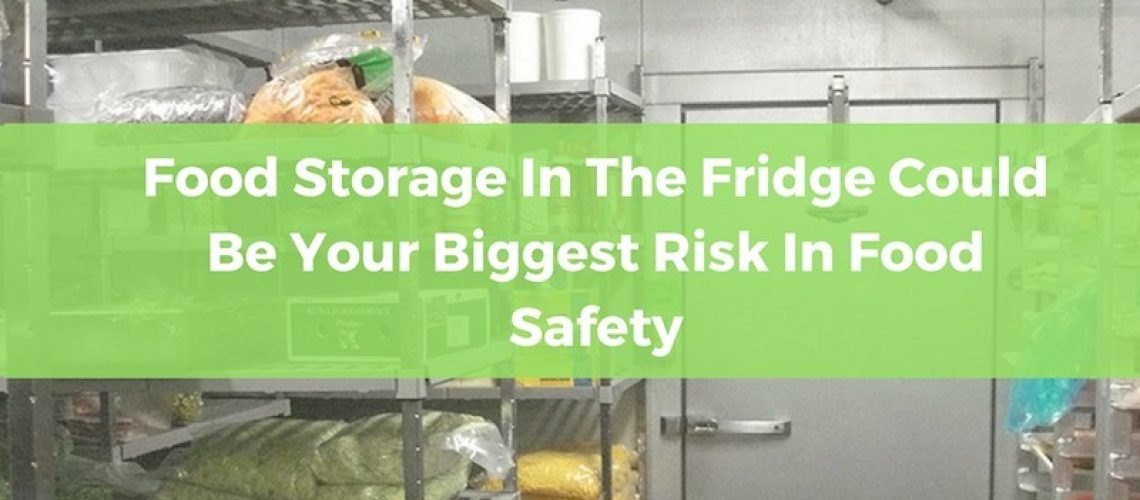Food storage in the fridge is one of the most important principles in food safety. Perishable foods by their very nature do not last as long as we would like. This is why we need to keep foods in the fridge. To prolong the time it takes for food to go off.
But keeping foods in the fridge is not just about temperature and keeping to the cold chain. It is also about storing foods in a way that prevents contamination and food poisoning. One of the biggest problems in the kitchen is storage space in fridges. The fridge is probably one of the most cramped spaces you’ll find. Everything from ready to eat meals, raw meats and veg to dairy and sauces all need to be stored in a fridge to ensure that foods do not expire before the use by date.
That leaves us with a large group of foods that need refrigeration and very little space to store them. The most ideal case would be to separate the food groups into their own fridges. That means raw meats should have its own fridge. Fruits and vegetables should be stored separately from dairy products. And ready to eat meals should be separated from each of the above.
The reality is, that most kitchens don’t have the luxury of separating their foods in this manner. One of the biggest mistakes kitchen still make today is that they store raw foods with ready to eat foods. Usually due to restricted space. So what is the safest alternative?
Food storage in the fridge according to the risks
The most efficient way to use your space effectively is to understand the risks of causing food poisoning. This means knowing what the risks of the various food groups are.
We know that raw meats and vegetables are risky because they have a high amount of bacteria that are naturally present in these foods. These foods are considered to have a high bacterial load. Collectively we will consider these uncooked foods. Notice that I didn’t mention fruits. Although fruits should be washed before use, they are not considered raw products because they are ready to eat. Meaning no further processing needs to happen before you can eat these foods.
The next category of foods are those that do not require any cooking or processing before food can be consumed. This includes salads, cooked foods, dairy and processed foods. These are the foods that should not have any bacteria present because they have a direct risk of causing food poisoning.
Raw Foods
Red meats, poultry and seafood are the main culprits when it comes to high bacteria load. We expect that these foods will have dangerous bacteria in them. So it seems logical that we want to keep these away from foods that should not have bacteria in them.
Vegetables, due to the farming process could contain bacteria in them. And are in the next risk category. We should never keep raw vegetables with salad ingredients and prepared foods. Vegetables especially those farmed organically, are not always washed and cleaned, removing the soil, chemicals and manure. These could contain bacteria seriously dangerous to our health.
Ready to eat foods
All prepared foods, cooked foods and dairy should be treated as ready to eat and should always be stored separately from raw foods.
How to store foods safety
So now we understand the risks of the food categories. And we know that we need to separate raw and ready to eat. How do we do this?
Raw meats should be stored on the lowest possible shelf
Red meats and poultry should be stored separately. This is because chicken is notorious for having Salmonella, Campylobacter and Listeria monocytogenes. More so than any other raw meat. However, if your space is limited, these products will be cooked and will kill these bacteria.
Fish and seafood should be stored on the same line but separately from raw meats
Seafood carries less dangerous bacteria and certainly different bacteria from the common food poisoning bacteria. However many people are prone to seafood allergies, especially shellfish such as prawns. You’d do well to keep these away from any other foods.
Vegetables should be stored on the nextlowest shelf above the raw meats
Most bacteria living on fruits and vegetables can easily be washed off with soapy water and a suitable vegetable sanitiser. These carry less bacteria and do not leak blood. Raw meats will always have some blood spillage, carry millions of bacterial cells. Usually, fruits and vegetables are stored separately from meats because they require different holding temperatures. Fruits and vegetables tend to change colour or lose their quality at cooler temperatures. Especially at temperatures that are required to keep meats fresh. The ideal operating temperature for a vegetable fridge is 5 – 7 ºC (41 – 45 ºF).
Salad ingredients and cooked foods should be stored above all else and can be stored with dairy
In ideal circumstances, the above foods should be stored separately from each other. But there is no risk if ingredients are correctly washed. Cooked foods can be kept for up to 3 days before the natural bacteria in these start to grow to high numbers causing foods to go off. Dairy products such as milk, cream, yoghurt and cheese are very low risk and do not harbour dangerous bacteria.
This seems fairly simple. And it can be if you store foods neatly and have sufficient space.
Let’s consider left overs, defrosting foods and foods that need cooling.
As mentioned, left overs or cooked foods if they were handled correctly and would be reheated can be kept for a maximum of 3 days. Defrosting foods, carry a high risk in the fridge, this is because during the defrosting process, juices and blood will collect and build up which can leak out and onto foods below.
Foods that are cooked and will only be needed or eat later should never be left out in the kitchen. This is because temperatures ranging from 20 – 45 ºC (68 – 113 ºF) are directly within the range at which bacteria rapidly multiply.
This means that cooling foods need to be placed in the fridge in an uncovered manner until cooled to the fridge temperature. This is a high risk time, when anything falling into these foods can cause contamination. This means that the top most shelf should be kept for the cooling process.
So we now know where to store foods.
How do we store foods in the safest possible way?
The next step in safe food storage is to further ensure no cross-contamination can occur. We do this by using sealable containers. Storing each food group into clear, sealable containers locks in freshness and prevents any outside contamination. This practise also ensures the longevity of your foods by limiting exposure to the outside environment. This prevents odours as well. Keeping a record of when food was prepared will help minimise expired foods and will help with the FIFO policy (First In Fist Out). This is achieved by the use of date codes.
Raw meats can either be left in their original containers until full defrosted or prepared. Whole fruits and vegetables should be transferred from any boxes, washed, rinsed and placed into plastic containers. These do not have to be covered, but should be fully dried before storing.
Any foods that undergo preparation. This can mean cutting, cooking, peeling etc. need to be placed in a sealable container and appropriately covered.
Sauces, milk, cream and any liquids that come with a re-usable lid should be kept in the original container. Cartons that cannot be closed should be transferred to sealable containers.
Wireless Temperature Monitoring systems have multiple uses across a variety of food related industries saving their clients health, time, money and reputational harm for those that use them.


